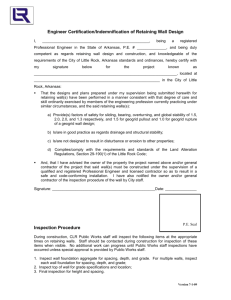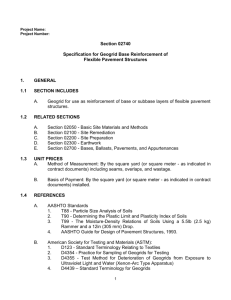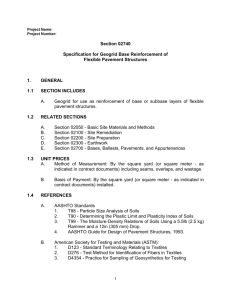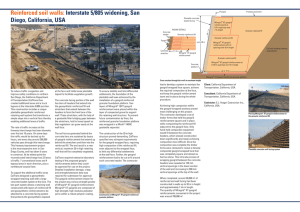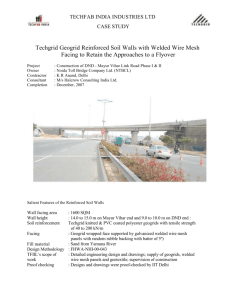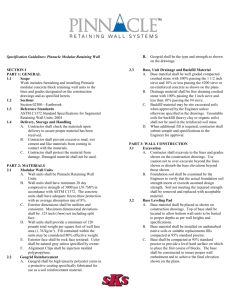SEISMIC STUDY OF REINFORCED EARTH WALLS BY SHAKING TABLE MODEL TESTS
advertisement
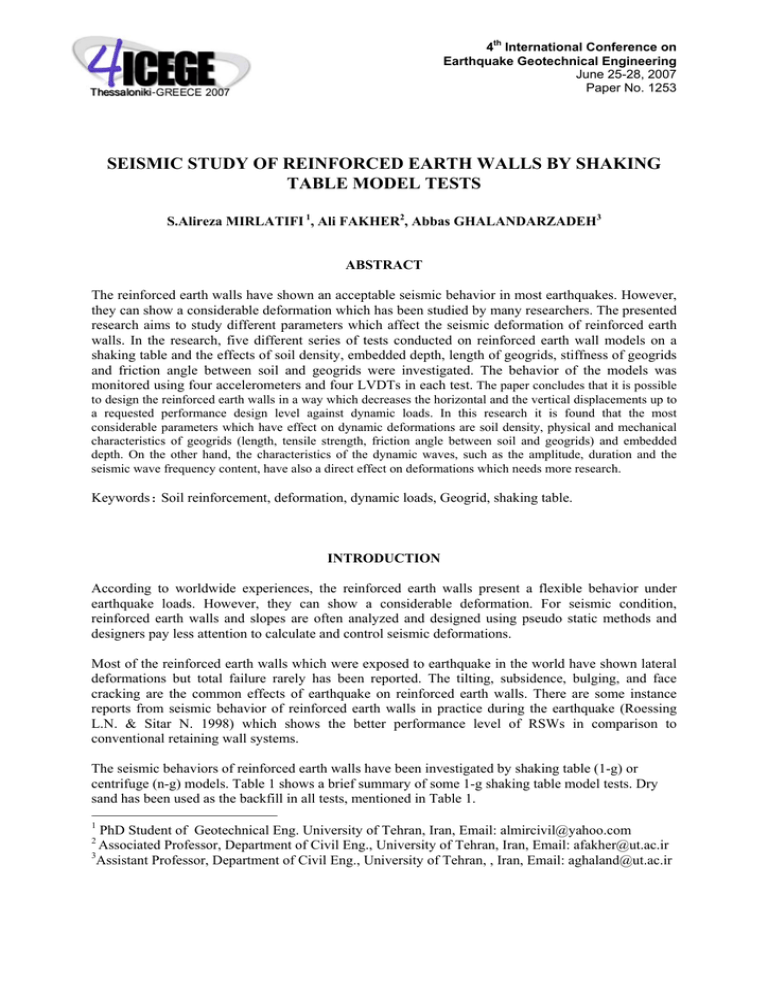
4th International Conference on Earthquake Geotechnical Engineering June 25-28, 2007 Paper No. 1253 SEISMIC STUDY OF REINFORCED EARTH WALLS BY SHAKING TABLE MODEL TESTS S.Alireza MIRLATIFI 1, Ali FAKHER2, Abbas GHALANDARZADEH3 ABSTRACT The reinforced earth walls have shown an acceptable seismic behavior in most earthquakes. However, they can show a considerable deformation which has been studied by many researchers. The presented research aims to study different parameters which affect the seismic deformation of reinforced earth walls. In the research, five different series of tests conducted on reinforced earth wall models on a shaking table and the effects of soil density, embedded depth, length of geogrids, stiffness of geogrids and friction angle between soil and geogrids were investigated. The behavior of the models was monitored using four accelerometers and four LVDTs in each test. The paper concludes that it is possible to design the reinforced earth walls in a way which decreases the horizontal and the vertical displacements up to a requested performance design level against dynamic loads. In this research it is found that the most considerable parameters which have effect on dynamic deformations are soil density, physical and mechanical characteristics of geogrids (length, tensile strength, friction angle between soil and geogrids) and embedded depth. On the other hand, the characteristics of the dynamic waves, such as the amplitude, duration and the seismic wave frequency content, have also a direct effect on deformations which needs more research. Keywords: Soil reinforcement, deformation, dynamic loads, Geogrid, shaking table. INTRODUCTION According to worldwide experiences, the reinforced earth walls present a flexible behavior under earthquake loads. However, they can show a considerable deformation. For seismic condition, reinforced earth walls and slopes are often analyzed and designed using pseudo static methods and designers pay less attention to calculate and control seismic deformations. Most of the reinforced earth walls which were exposed to earthquake in the world have shown lateral deformations but total failure rarely has been reported. The tilting, subsidence, bulging, and face cracking are the common effects of earthquake on reinforced earth walls. There are some instance reports from seismic behavior of reinforced earth walls in practice during the earthquake (Roessing L.N. & Sitar N. 1998) which shows the better performance level of RSWs in comparison to conventional retaining wall systems. The seismic behaviors of reinforced earth walls have been investigated by shaking table (1-g) or centrifuge (n-g) models. Table 1 shows a brief summary of some 1-g shaking table model tests. Dry sand has been used as the backfill in all tests, mentioned in Table 1. 1 PhD Student of Geotechnical Eng. University of Tehran, Iran, Email: almircivil@yahoo.com Associated Professor, Department of Civil Eng., University of Tehran, Iran, Email: afakher@ut.ac.ir 3 Assistant Professor, Department of Civil Eng., University of Tehran, , Iran, Email: aghaland@ut.ac.ir 2 Table1. Summary of shaking table tests on reinforced earth walls and slopes (after NovaRoessig, 1999)-including present research Reference Model H-mm prototype H-mm 34005200 L/H 0.62.2 Input Motion Reinforced Material Sinusoid Mylar/alum. strip Curved alum. Wraparound, sandbag Concrete block Full height rigid facing Full height/woo d panel Wrapped Richardson 1974,75 280420 Koga et al. 1988,91 10001800 7300 0.52.3 Sinusoid Bathurst et al. 1996 Koseki et al. 1998 1020 6100 0.7 Sinusoid 500 0.4 Sinusoid steel bar, geogrid, geo-textile weak geogrid grid strip Matsuo et al. 1998 10001400 0.40.7 Sinusoid geogrid Perez 1999 1220 0.280.5 Sinusoid geotextile Mirlatifi et al. 2003 (current research) 600 0.70.9 Sinusoid geogrid 6100 Facing Material Wrapped geogrid Reported Failure (rupture) contained, linear f.s.; ductile (pullout) Some settlement, lateral movement Toppling/sliding of top facing block Partly contained/uncontained f.s.; overturning; no rupture Partly contained f.s.; no rupture Distinct f.s., moderate lat./vert. movement contained f.s.; moderate lat./vert. movement, ductile pullout Abbreviations: f.s.-failure surface According to the researches on reinforced earth walls, the important parameters which have effect on the deformations of the RSWs are soil density, amplitude of the motion, length and spacing of the reinforcements, tensile strength and soil interaction friction angle between reinforcements, facing material (Sara B. Paulsen & Kramer 2002, Roessing L.N. & Sitar N. 1998). In this research the spacing between the reinforcements are constant in all tests. SHAKING TABLE MODEL TESTS Similitude rules for shaking table tests Dimensional analysis is a conceptual tool which should be applied in physical model tests to understand the similarity of the model and the prototype when a number of influential physical quantities are involved. Therefore, three independent factors have been chosen in geotechnical model tests to similitude and finding true scale between model and prototype: 1) (λ) geometrical factor, 2) (λp) soil density factor, and 3) (λε) soil strain factor. Similitude rules for a geotechnical model with the factor of λ, λp, and λε in medium and small strain ranges are in Table 2. In this research it is assumed that λp= λε = 1 which can be a true assumption. Furthermore, Perez (1997) has also recommended some similitude rules for shaking table 1-g tests for reinforced earth walls. The results also illustrates in Table 2 (Sarah B. Paulsen 2002). Table2. Similitude rules for reinforced earth walls in shaking table model tests (1-g) Quantity Length Soil density Soil strain Time Displacement Acceleration Stress Soil parameters (C, φ,) Tensile strength of geogrid Interaction friction angle Similitude Factor λp= λe = 1 (med. to small strains) Perez(1997) Current applied factor λ λp λε (λ.λε)0.5 λ.λε 1 λ. λp λ 1 1 (λ)0.5 λ 1 λ λ 1 1 λ λ 1/λ λ λ 1 1 (λ)0.5 λ 1 λ - - 1 1 - - λ λ - - 1 1 Model Configurations A total of eleven tests were undertaken in the presented research. The model walls were 600 mm high. Figure 1 illustrates a typical reinforced earth model wall with wrapped geogrid facing. The reinforcement vertical spacing in the model is 100 mm and the length of them, L, was chosen to give L/H = 0.7, where H is the height of the model. In some other configurations the length of geogrids increased to 0.9 H in two upper layers. These eleven tests were grouped into five different kinds of test configurations (Table3): 1- Reinforced earth walls with compacted sand (Dr=90%) with geogrid type A with the length of 0.7H. 2- Reinforced earth walls with loose sand (Dr=50%) with geogrid type A with the length of 0.7H. 3- Omission of embedded depth. 4- Reinforced earth walls with loose sand (Dr=50%) with geogrid type A with increasing the length of two upper layers to 0.9H. 5- Reinforced earth walls with loose sand (Dr=50%) with geogrid type B with increasing the length of two upper layers to 0.9H. Figure1. A typical reinforced earth model wall with wrapped geogrid facing Table3. Five groups of the reinforced earth wall configurations Geogrid properties Group Type Length of two upper layers Length of 4 down layers 1 A 0.7H 2 A 3 Soil Density Embedded Depth (mm) 0.7H 90% 60 0.7H 0.7H 90% 60 A 0.7H 0.7H 50% 60 4 A 0.7H 0.7H 50% 60 5 A 0.7H 0.7H 50% 60 6 A 0.7H 0.7H 50% 60 8 A 0.7H 0.7H 50% ZERO 9 A 0.9H 0.7H 50% 60 10 A 0.9H 0.7H 50% 60 11 B 0.9H 0.7H 50% 60 Test No. Duration=8 sec A.IA=3.11 m/s2 Duration=18 sec A.I.A=3.78 m/s2 Duration=15 sec A.I.A=4.34 m/s2 Duration=17 sec A.I.A=4.2 m/s2 Duration=15 sec A.I.A=4.0 m/s2 Duration=14 sec A.I.A=3.79 m/s2 Duration=16 sec A.I.A=3.8 m/s2 1 2 3 Duration=15 sec A.I.A=4.0 m/s2 4 5 Input Motion Characteristics Duration=11 sec A.I.A=3.75 m/s2 Duration=16 sec A.I.A=3.91 m/s2 A.I.A: Amplitude of Input Acceleration Tested materials The backfill material used in the model tests was uniform silicate crashed Firoozkooh sand which is used in the soil mechanic laboratory of the University of Tehran [1, 2, and 3]. The brief summary of physical characteristics of this sand is in Table 4. Two types of geogrids (A, B) were used for reinforcement in the current research. These geogrids were manufactured for non-structural purposes. However, because of similitude rules they were used in this research. The tensile strength of the geogrid A and B is 2 KN/m and 1.4 KN/m respectively. Also the interaction friction factor of geogrid B is 1.4 times more than Geogrid A, because the texture of the geogrid B is coarser than geogrid A. The sieve sizes and thickness of these two types of geogrids are equal. The sieve size is 2*2 mm and the thickness is1.1 mm. Gs Firoozkoo h sand 2.658 Table4. Silicate crashed Firoozkooh sand characteristics emax emin D50 %F Cu 0.943 0.603 0.3 mm 0 2.58 Cc K(cm/sec) 0.97 0.0125 Instrumentation, model set up, and base excitation Figure1 elucidates the configuration and layout of the model. Totally, four accelerometers and four LVDTs were deployed in each model wall. The displacements of the wrapped geogrid facing were measured using LVDTs mounted against the facing in four levels from the base to the top of the model. Also, accelerometers were used to measure acceleration response from the base to the top of the model in four levels. Data from all instruments recorded by 10 channel dynamic data logger with sampling rates great enough to capture peak dynamic response values. The base input motion is a harmonic sinusoidal with a frequency of 2.7 Hz. Model Construction Procedure First, the base soil was compacted beneath the model. Then, in sequence soil layers were poured uniformly on the geogrid layers. In addition, to impede spilling out of the sand through out the sieve of geogrid facing, a thin tissue has used behind the facing. Also, colourful sand has used to observe the wall deformations. Furthermore, liquid oil has been rubbed to lubricate the wall of the model box to reduce the friction between sand and model box. During the construction, accelerometers were installed. Then, the embedded depth equal to 60 mm constructed after wall construction. Finally, LVDTs and cameras installed in order to record the results. MODEL TEST RESULTS In these series of tests the accelerations and displacements of the model in four levels have been recorded versus time. The details of all results have been described by Mirlatifi, S.A., 2003. However; Figures 2 to 5 show the results of Test 6 and 11. Acceleration-Time(test11) 6 4 2 0 -2 -4 -6 6 4 2 0 -2 -4 -6 6 4 2 0 -2 -4 -6 topacc. 250 500 750 1000 1250 1500 1750 2000 2250 2500 acc.2 250 500 750 1000 1250 1500 1750 2000 2250 2500 acc.1 250 500 750 1000 1250 1500 1750 2000 2250 2500 Acceleration(m/s2) Acceleration (m/s2) Acceleration-Time(test06) 6 4 2 0 -2 -4 -6 500 750 1000 1250 1500 1750 2000 2250 500 750 1000 500 1500 2750 750 1000 1250 1500 1750 2000 2250 2500 2750 750 1000 1250 1500 1750 2000 2250 2500 2750 baseacc. 750 1000 1250 1500 1750 2000 2250 2500 2750 Figure3. Time history of the acceleration-Test 11 Deformation (mm) Deformation(mm) 2500 Deformation-Time(test11) L1 L2 L3 L4 1250 2250 acc.1 500 Deformation-Time(test06) 1000 2000 Time(*.01) sec 0 -5 -10 -15 -20 -25 -30 -35 -40 -45 -50 -55 750 1750 4 2 0 -2 -4 -6 500 2500 Figure2. Time history of the acceleration-Test 06 500 1500 acc.2 Time(*.01)sec 250 1250 4 2 0 -2 -4 -6 4 2 0 -2 -4 -6 baseacc. 250 topacc. 4 2 0 -2 -4 -6 1750 2000 2250 2500 Time(*.01) sec Figure4. Wall displacements Vs time-Test 06 0 -5 -10 -15 -20 -25 -30 -35 -40 -45 -50 -55 L1 L2 L3 L4 500 750 1000 1250 1500 1750 2000 2250 2500 Time(*.01) sec Figure5. Wall displacements Vs time-Test 11 Amplification of the Acceleration In Test 01 and 02 the displacements were very small (about 1mm). Moreover, the maximum of the amplification of the acceleration happened in 200 mm from the bottom of the model (one third of the height) not in the top of the wall (Figure6). The amplitude of the acceleration of the input motion was 3 m/s2 in this test. The amplification of the acceleration increased from bottom to the top of the wall in Tests 03 to 06 (Dr=50%). In the Test 03 the acceleration reached even to 8 m/s2 in top of the wall which showed the amplification factor of 2.28. In the Test 08 which the embedded depth has been omitted, the amplification factor was similar to the Tests 03 to 06.In the Tests 09 and 10 which the 2750 length of geogrids in two upper layers have been increased from 0.7 H to 0.9 H, the amplification factor has been decreased from 1.3 to 1.25 averagely. Also, the amplification factor decreased more in Test 11 with geogrid B. It is important to note that in 0-4 seconds from beginning of the tests, the amplification factor was more than the end of the tests in 10-15 seconds because of the densification of the loose sand by the vibration. test02-sec(12-20) 8 6 4 2 0 acc1 topacc. -2 -4 -6 -8 -8 -6 -4 -2 0 2 4 6 8 Base Acceleration(m/s2) Figure6. Amplification of acceleration in 200 mm from the bottom (Bulging)-Test02 Geogrid Wall Deformations In the Tests 01 and 02 (Dr=90%) the maximum of the displacement occurred in 200 mm from the bottom of the wall and the amount of displacement was about 1mm (bulging of the wall). In the Tests 03 to 06 the maximum of the displacements observed in the top of the wall and it was 43.5 mm (tilting of the wall). Figure7 shows the displacements of the wall in L=0.7H and Dr=50%. This behaviour has been seen in some other researches (Bathurst &EL-Emam, 2002). When the embedded depth changed to zero, it did not effect the displacements of the wall at upper parts. However, a large displacement was observed at the bottom of the wall when the embedded depth was zero. It confirms the behavior of reinforced walls reported by Bathurst &EL-Emam, (2002). Figure7. Displacements of the geogrid wall (L=0.7H, Dr=50%) (Tilting) The length effect of geogrids on wall deformation In the Tests 09 and 10 the length of the geogrids (type A) increased from 0.7H to 0.9 H in two upper layers. In this case, it was seen that displacements in the top of the wall reduced about 50% by increasing of the length of the reinforcements from 0.7H to 0.9H (30% increase) in two upper layers, (Figure8). Figure8. Displacements of the geogrid wall (L=0.7H, 0.9H, Dr=50%, Geogrid A) Soil and Geogrid Interaction Friction Angle Effect on Wall Deformation In the Test 11 the soil and geogrid interaction friction angle effect on the wall deformation have studied. In this test the geogrid type B was used instead of type A. In this case, the tensile strength of geogrid A is more than geogrid B and the stiffness of geogrid A is about 5 times more than Geogrid B. However, the Interaction friction factor between soil and geogrid B is 1.4 times more than geogrid A. In this test (Test11) the maximum displacement on top of the wall decreased from 24.85 mm to 20.88 mm by changing the geogrid A with geogrid B (Figure9). On account of this fact, it can be resulted that although the tensile strength and stiffness of the geogrid A is more than geogrid B, the deformation of the wall in the case of geogrid B is lesser than geogrid A. This is because of the interaction friction angle of geogrid B which is more than geogrid A and the mode of the deformation is pullout (not yielding of reinforcements). Indeed, when the tensile strength and stiffness of reinforcements are high enough, the mode of failure is pullout not yielding of reinforcements. Therefore, the tensile strength and stiffness in the mode of pullout is not important and the interaction friction angle between soil and reinforcements is controlling the deformation rate. Figure9. Displacements of the geogrid wall (L=0.7H, 0.9H, Geogrid A, B) The Failure Zone The failure zone was clearly observed behind the reinforcements because of the movement of the geogrid wall. The failure zone can be divided in two parts. First is the central zone which has failed and settled clearly. Second is the boundary zone between backfill soil and the central failure zone which is a transitive failure zone (Figure10). When the length of two upper layers was increased, the failure zone moved back and became narrow (Figure11). It is seen that the failure zone developed more when the embedded depth omitted. Figure10. The central and transition failure zone (L=0.7H) Figure11. The narrow failure zone (L=0.9H) General Pattern of Geogrid Wall Deformation It is concluded from all of tests that the deformation mode of conventional geogrid walls follows from two main deformation patterns, a) Bulging b) Tilting. Figure12 illustrates these patterns. It was seen that the pattern of the geogrid wall deformation depends to "the relative general stiffness" of the geogrid wall and the amplitude of the earthquake loads. Indeed, while the relative general stiffness of the geogrid wall decreases (i.e. low soil density, short length of reinforcements, low interaction friction angle, high height of the wall) and the high amplitude of earthquake happens, the deformation pattern of tilting (b) is more probable. On the other hand, while the relative general stiffness of the wall increases (i.e. dense soil, long reinforcements, high interaction friction angle, and low height of the wall) and the low amplitude of the earthquake loads happens, the deformation pattern of bulging (a) is more probable. Indeed, the effect of each parameter is very important to determine the pattern and mode of deformation. It was predicted that by defining an Index parameter which includes the height of the wall, length and interaction friction angle, soil density, amplitude, and frequency content of dynamic load, the deformation pattern can be predicted and controlled in pullout mode which needs more research. However, other parameters such as tensile strength and stiffness of geogrids should be taken into account in yielding mode of failure. Figure12. The most probable deformation mode of conventional geogrid walls CONCLUSION Some important conclusions from the presented research are summarized below. 1- When a dense fill (Dr= 90%) is used, the deformation of the model wall is considerably smaller than the cases with loose fill (Dr=50%). Almost, no amplification of acceleration was observed when a dense fill is used. However, the amplification factor was reached to 2.28 in top of the wall and a tilt was observed when a loose fill and 0.7 H long reinforcements are used. 2- The displacements of the bottom of the wall increased a little and the zone of failure widely developed with the omission of the embedded depth. Furthermore, the vertical displacement on the top of the wall substantially increased in this case. 3- The displacements of the wall decreased greatly and the amplification factor in top of the wall decreased from 1.3 to 1.25 when the length of the two upper layers of geogrids increased from 0.7 H to 0.9 H. 4- Although the tensile strength and stiffness of the Geogrid A is greater than Geogrid B, the deformation of the wall decreased greatly when Geogrid B is substituted by Geogrid A. Because the interaction friction angle between geogrid B and soil is more than geogrid A. Indeed, the friction angle between geogrid and soil is the effective parameter when the mode of failure is pullout because of high tensile strength of the geogrids. 5- Two shapes of a deformed geogrid wall, named bulging and tilting were observed in the tests. The shape of a deformed wall depends to the dynamic loads and wall characteristics. Tilting shapes are created when the earthquake is very strong and/or the wall is not stiff. Bulging shapes could be seen when the earthquake is not strong and/or the wall is very stiff. REFERENCES Bahadori, H., "Cyclic behavior of saturated sands under extensional triaxial loading", M.S thesis, University of Tehran, by Dr Ghalandarzadeh.A, 2002. Bathurst & EL- Emam, "Shaking table model study on the dynamic response of reinforced soil walls." Geosynthetic 7th Conf., Canada, (2002). Fakher, A., and Jones, C.J.F.P., "When the bending stiffness of geosynthetic reinforcement is important", Geosynthetics International Journal, Volume 8, No.5, pp.445-640, (2001). Fakher, A., Nouri, H., Shahgholi, F., "Limit Equilibrium in Reinforced Soil Wall Subjected to Seismic Load", Proceeding of the Third Iranian Conference on Geotechnical Engineering and Soil Mechanics, Tehran, Vol. 3, PP.281-286, (2002). Ghionna, "Full scale test on retaining wall with non-uniform Reinforcements" Geosynthetic- 7th, Italy, (2002). Guler E., & Hamderi, "FEM analysis of reinforced segmental retaining walls with cohesive and granular backfills", Geosynthetic- 7th Conf., Turkey, (2002). Hatami, K., "Calibrated numerical simulation of response of soil retaining walls under static loading", Royal Military College of Canada, (1998). Haghighat, S., "The effect of total stress and lateral strain proportion on saturated undrained sands with triaxial compression tests", M.S thesis, University of Tehran, by Dr Ghalandarzadeh, A., 2001. Iai. S., "Similitude for shaking table tests on soil structures- fluid model in 1-g gravitational field", Soils and foundations, JSSMFE, 29(1).105-118, (1989). Khatibi, A., "Seismic study on mat foundation and remedial measures against liquefaction on shaking table model tests", M.S thesis, University of Tehran, by Dr Ghalandarzadeh, A., 2002. Matsu O. & Tsutsumi, T., Yokoyama, K. & saito, Y, "Shaking table tests and analyses of geosynthetic-reinforced soil retaining walls", Geosynthetic International Conf. 5(1-2): 97-126, (1998). Mirlatifi, S.A., "Seismic study of reinforced soil walls with geogrid with shaking table model test (1-g)", M.S thesis, University of Tehran, by Dr Fakher, A., 2003. Nouri, H., "Development of horizontal slice method for seismic stability analysis of reinforced slopes and walls", M.S thesis, University of Tehran, by Dr Fakher, A., 2003. Nouri, H., Fakher, A., Jones, C.J.P.F., "Development of Horizontal Slice Method for Seismic Stability Analysis of Reinforced Slopes and walls", Geotextile and Geomembrain, To Be Published, (2006). Perez, A. (1999)."seismic response of geosynthetic reinforced steep slopes", M.S. Thesis, University of Washington, 232 pp. Roessing L.N. & Sitar N., "Centrifuge studies of the seismic Response of Reinforced soil slopes". Third Geotechnical Engineering and soil Dynamic conference, Geotechnical special publication No. 75, ASCE, Pp.458-468, Seattle, Washington, (1998). Roessig L.N. & Sitar N., "Centrifuge Model Studies of the Seismic Response of Reinforced Soil slopes" Proceeding of the Second Int. Conf. on Earthquake Geotechnical Engineering, University of California. Berkeley, USA, (1999). Shahgholi, M., Fakher, A., Jones, C.J.F.P., "Analysis of reinforced slopes and walls using Horizontal Slice Method ", Landmarks in Earth Reinforcement, Ochiai et al. (eds) IS Kyshu, Vol. l, pp. 277279, (2001). Shahgholi, M., "Horizontal slice method of seismic deformation analysis of reinforced soil walls", M.S thesis, University of Tehran, by Dr Fakher, A., 1999. Saber Mahani, M.," Experimental and analytical seismic deformation study on reinforced earth walls", PhD. Thesis, University of Tehran, by Dr Ghalandarzadeh, A. & Dr. Fakher, A., under research, 2005. Sarah B. Paulsen, "A numerical Model for Estimating Siesmic Displacements of Reinforced Steep Slopes", M.S thesis, University of Washington, by Prof. Steven L. Kramer, (2002). Shahgholi, M., Fakher, A., & Jones, C.J.F.P., "Horizontal Slice Method of Analysis ", Geotechnique, 51, No.10. 881-885, 2001. Shahgholi, M., Fakher, A. and Jones, C.J.F.P. “Closure of discussion by Lam and Li on Horizontal slice method of analysis”, Geotechnique, Vol. 52, No.9, pp. 697-699, (2002). Steedman, R.S., & Zeng. X, "The influence of phase on the calculation of pseudo- static earth pressure on retaining wall", Journal of Geotechnique, Vol.40.No.1.103-112, (1990). Tatsuoka, F., Tateyama, M. and Koseki, J., "Performance of soil retaining walls for railway embankments" Soil and Foundation, Vol.45, No.3.p.311-324, (1996). Zorenberg, J., "Performance of Geotextile-Reinforced Soil structures" Ph.D. Thesis, University of. California, Berkeley, (1994).
